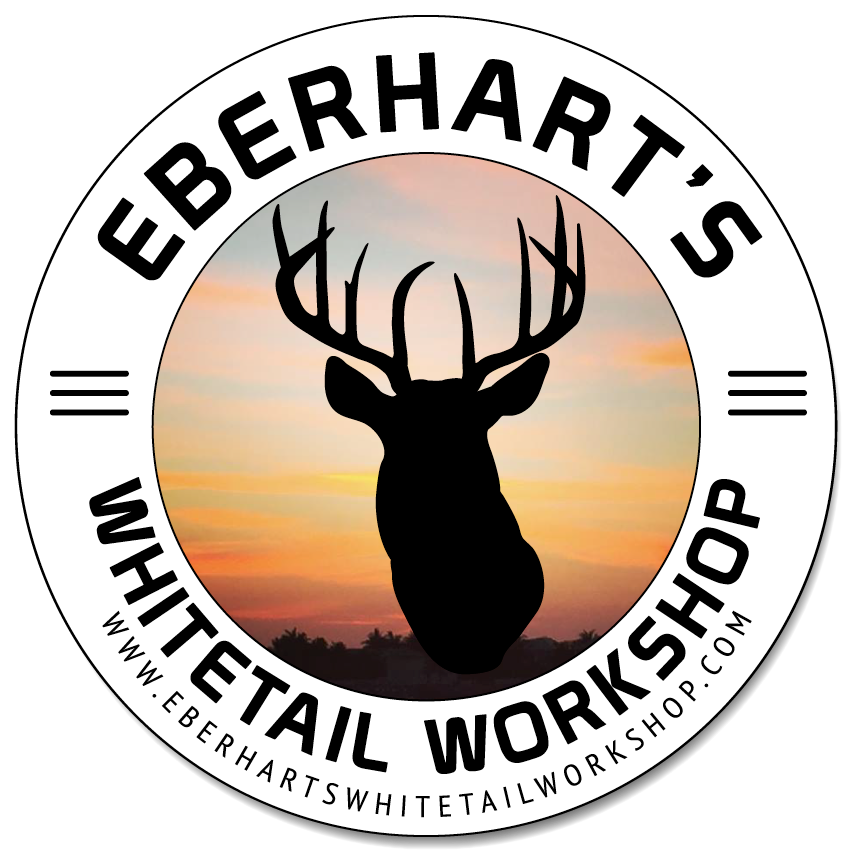Advantages of a 2-panel Eberhart Signature Saddle (ESS) over other saddles and what each feature is designed for:
Before we get into the ESS advantages, these are my personal hunting qualifications and why I modified and re-designed the unique 2-panel saddle I bought and hunted from for over 40 years to come out with the ESS by Tethrd:
Since 1981, when hunting from trees I have exclusively hunted from a 2-panel saddle and have an accumulative total of 50 record book bucks (31 from Michigan and 19 from 5 other states). 44 of those 50 book bucks were taken from a 2-panel saddle and they came off 32 different properties and from 39 different trees.
What separates those accomplishments from any other hunter in the country that I know of is they all were taken from either public lands, knock-on-doors for free permission or free walk-on-hunting properties. I’ve never owned, leased, hunted a relative’s property or paid a dime to hunt anywhere, and never will.
I’ve also taken about 50 other bucks and well over 100 does for the freezer during my 41 seasons of hunting from a saddle and directly attribute the taking of about half of those deer to the many advantages that hunting from a saddle has over hunting from any type of conventional hang-on, climber or ladder stand.
Here are the advantages an ESS has over single panel saddles and other 2-panel saddles and I have sat in about every saddle design ever brought to market.
–Quite frequently during a hunt, most single panel saddles will ride up into the hunters lower back causing discomfort and the need for the hunter to lift his or her weight from the seat to readjust it back under their butt. Because a single panel saddle is one piece, when the top of the saddle slightly rides up due to body movements when hunting, the bottom rides up with it and anytime the saddle rides up from the crease at the bottom of your butt cheeks, it will be very annoying and uncomfortable and have to be adjusted back.
The ESS is a 2-panel saddle that will NOT ride up because the 2-panels work independently of each other. The inner seat panel comfortably cups under your butt and ALWAYS remains firmly in place under your butt no matter where you adjust the outer panel to or if the outer panel slightly moves while hunting.
-Concerning seat depths, single panel saddle seats are what they are, and they can’t be adjusted. Some have shallow seats, and some seats are quite deep. For experienced hunters a shallow seat is fine because they just want the seat to cover their butt, whereas a new saddle user may feel insecure sitting in a shallow seat and would feel more secure with a seat that comes up into their lower back. Of course, the new hunter would not fall from a shallow seat, but would feel more comfortable, safe and secure sitting in a deeper seat with back support.
With the 2-panel ESS the hunter can widen the seats depth by simply leaving the inner panel under their butt and raising the outer panel up to whatever position they feel comfortable and safe in. As a hunter becomes more proficient and comfortable with hunting from a saddle they can adjust the outer seat panel accordingly for whatever depth of seat desired, and will almost always gravitate to a shallower seat depth. You can’t do that with any single panel saddle.
Even after 40 seasons of hunting from a saddle, depending on the situation, during a hunt John prefers having unlimited options in seat depths and weight distribution which equates to more overall comfort and less fidgeting and the 2-panel ESS accommodates those situations.
While the inner panel ALWAYS remains under your butt during a hunt, you can adjust the outer panel to whatever is most comfortable for the type and shape of tree you’re hunting, how much clothing you’re wearing per the weather conditions or whatever seat depth adjustments you may need at any time.
-Hunter’s come in many shapes, sizes and weights and whether they are new to saddle hunting or are well-seasoned, the 2-panel ESS can adjust to fit any hunter up to a 44-inch waist. For larger hunters the ESS also more evenly distributes their weight over the four 2-inch-wide straps (each panel has two, 2-inch-wide straps) that cradle their weight. Single panel saddles have 1 two inch wide strap along the bottom of the saddle and one along the top with some type of fabric between them, and most of your weight is supported by the single strap along the bottom and during long sits, the strap along the bottom will become a stress point of discomfort.
-A very important innovation of the ESS is its smooth aluminum D-rings. The D-rings act as the saddles bridge loops (most other saddle bridge loops are fabric) to which the adjustable bridge strap is connected. During a hunt, whenever the outer panel is adjusted to change the seats depth, the bridge strap automatically slides on the respective D-rings to even out the hunter’s weight distribution in the seat. The smooth aluminum D-rings is what also separate an ESS 2-panel saddle from all other 2-panel saddles.
Single panel saddles have fabric bridge loops and once the hunter’s weight is seated, the fabric bridge rope or strap will somewhat bind to the fabric bridge loops and remain in that position. Whenever the hunter moves the seat, they have to manually adjust the bridge rope or strap on the bridge loops to hopefully hit the sweet spot to even the weight distribution in the seat and more importantly to help keep the saddle under their butt. Most single panel saddles have side adjusters to help keep the saddle tucked under your butt, and if riding up wasn’t such an issue with single panel saddles, those side adjusters wouldn’t be there.
There are no side adjusters on an ESS because the seat riding up is not an issue.
-A common comfort issue with single panel saddles is not being able to easily change your clothing for temperature changes while on stand for long periods of time. The 2-panel ESS makes this process very simple.
The hunter simply adjusts the outer panel so that it slightly overlaps the inner panel under their butt and then the hunter can change with ease because there is nothing impeding their waistline. Removing jackets and layer garments with long hemlines is easy and once changed, the hunter can tuck everything in, put the jacket back on and adjust the outer panel back up to their desired comfort position and the bridge will automatically slide on the smooth D-rings to equal out the weight distribution during each of the processes.
-An issue with some single panel saddles is that the sides of the seat put pressure on your hips, and you can’t do anything about it. This is called hip pinch and due to the ESS having four 2-inch wide straps supporting your weight, and a different seat design, hip pinch is rarely ever an issue no matter how the 2-panels are separated to form the seat. If the need be, with the ESS you can adjust the 2-panels apart so that your hip bone is exposed between them so there are no pressure points.
An ESS is also more comfortable with hunters that have back issues as I have. If you have back issues, the 2-panels can be adjusted to eliminate any discomfort.
Here are a few examples of the advantages of an ESS 2-panel saddle:
Example 1: In a location where deer could come in from any direction, your upper body needs to have the ability to twist at the waist for more shot opportunity movements. With the ESS 2-panel design you can adjust the seat depth so that the outer panel rides below your waistline which will allow you to easily twist at the waist to shoot behind you.
Deep single panel saddle seats that ride up into your lower back will lock your upper body to your lower body making it difficult if not impossible to twist at the waist for a 6 o’clock shot behind you. In that case you would need to move your feet to another position which creates more body movements and the odds of getting picked.
Example 2: When hunting where deer are coming to a very specific destination location such as at an active scrape area or a mast or fruit tree that’s dropping food, John adjusts the outer panel to make the seats depth a bit deeper from what he normally has it. At destination locations your shot will typically be to a very small area where having a shallower seat for more upper body mobility is not needed.
Example 3: In awkward shaped or leaning trees that might seem uncomfortable when using a normal shallow seat depth, you can adjust the outer panel up to deepen the seats depth to FEEL more secure than if the seat were shallow.
Example 4: On morning hunts John is typically on stand an hour and a half prior to daybreak so as not to spook anything with his entry and during that hour and a half he will ALWAYS keep the inner seat panel under his butt and adjust the outer panel up into his lower back and then wrap his arms around the tree tether and lean forward and rest his head on the tree tether rope and rest for a while. When daybreak cracks, he will slide the outer panel down into whatever position he chooses for the hunt.
Example 5: On long entries John always goes in wearing as minimal clothing as possible (always wears a properly cared for exterior ScentLok jacket, pants and gloves during entries and exits so as not to leave any human odor on the vegetation he brushes against or touches) so as not to overheat and sweat and carries his layering undergarments in his backpack. Once up the tree and safely tethered in, he will slightly overlap the panels under his butt, remove his ScentLok jacket, put on the layering undergarments from his pack, tuck them into his pants, put the jacket back on and lastly slide the outer panel up over the jacket to whatever depth of seat he wants for the hunt.
Let’s end with safety:
From a safety standpoint, when purchasing a saddle make certain it has passed the TMA (Tree stand Manufacturing Association) 300-pound drop tests and has liability insurance. TMA was established to create a higher standard because there were so many conventional stands being made with inferior welds and materials that would not withstand the weight limits they were rated for.
Although the weight bearing load limits of the buckles and fabrics used to make a saddle may be well above the weight capacity of anyone that will ever use it, doesn’t mean the stitching material, stitching design, stitch and thread counts, belts, straps and ropes are sewn and manufactured in such a manner that the saddle will hold the 300-pound body shaped dummy in the saddle during the 3 drop tests performed by TMA. It is a simple task to ask the manufacturer if their saddles passed the TMA testing and if they reply by saying they were never tested, it is probably because they couldn’t pass the tests.
Liability insurance is extremely expensive and will add about $15 to $20 to the retail cost of a saddle. Whether purchasing a saddle or anything used of the ground for your spouse, kids, a friend or yourself, it should lend peace of mind knowing the saddle passed the safety testing offered by TMA and has liability insurance. After all, the saddle you purchase will be supporting your life.

